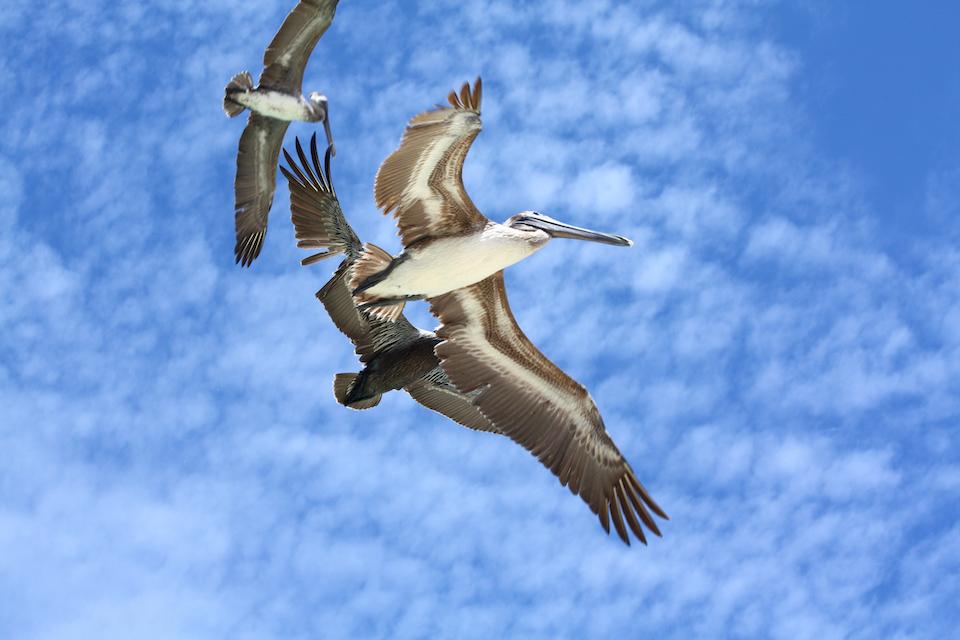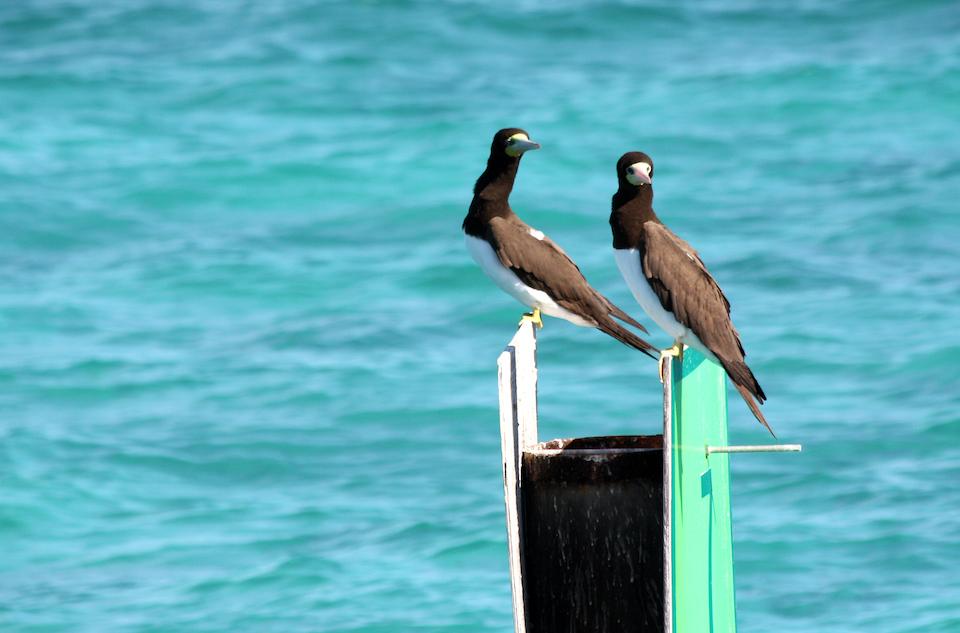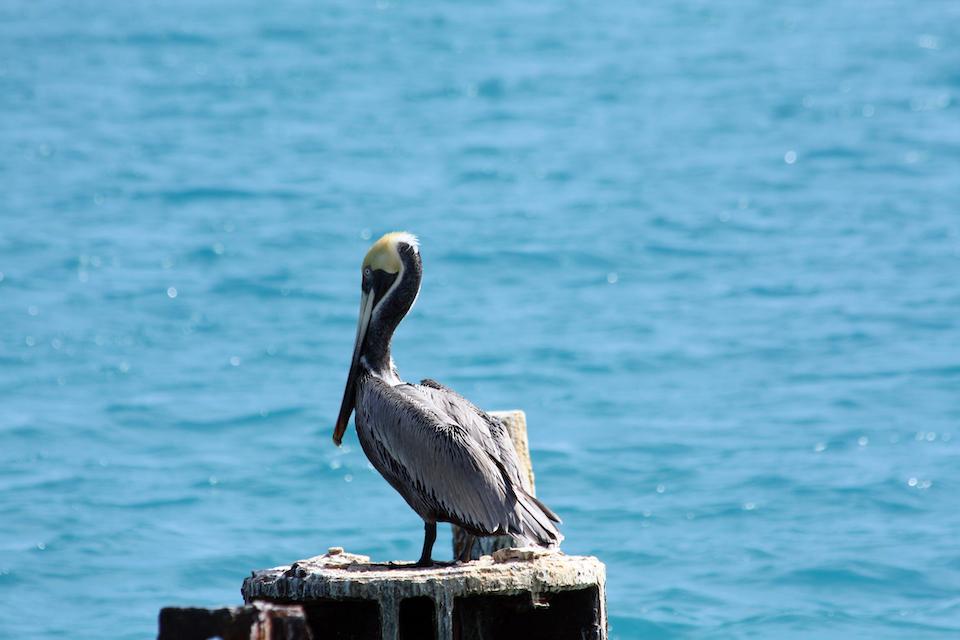
Pelicans wheeling above Dry Tortugas National Park/Yankee Freedom
Editor's note: The following is advertiser-supplied content.
For migrating birds who make their homes in distant lands, the yearly journey is tough and fraught with danger. While the instinct for survival is strong in humans, other mammals, reptiles, insects, and the group of endothermic vertebrates, known as birds, have been perfecting it long before the recording of time.
Birds from the Northern Hemisphere, for instance, flock northward in the spring to take advantage of large populations of insects, burgeoning plant life, and a plethora of nesting locations. This often perilous and long migratory journey ensures their offspring nourishment when food supplies dwindle, and alleviates local nesting sites overcome with a massive influx of birds competing for the best spots to lay their eggs. Were this not to happen, natural predators would have no trouble making an easy meal of them.
Another big reason that compels birds to migrate is the climate. Over millennia, birds have adapted to their environment by developing a specific type of plumage that allows them to thrive and adapt. However, even Arctic birds must seek warmth when temperatures dip, as do those living in tropical climes that can prove too harsh for the survival of their delicate chicks.
Dry Tortugas National Park is renowned as a prime location amongst bird aficionados eager to witness a wide variety of migratory birds. The park is one of over 500 sites across the State of Florida designated as the Great Florida Birding Trail.
The Great Florida Birding And Wildlife Trail -- An Overview

Brown boobies at Dry Tortugas National Park/Yankee Freedom
This trail, dedicated to the appreciation and conservation of Florida’s bird and wildlife populations, is a 2,000-mile long expanse along which the state's bird habitats are protected. The trail promotes birdwatching, environmental education, and ecotourism. Modeled after the Great Texas Coastal Birding Trail, it is divided into four distinct territories: Panhandle, West, Eastern, and South. Of the state’s 514 species of bird, a great many of them can be seen along this route.
Birding Seasons
Bird migration to the Dry Tortugas is a year-round affair. While the spring brings about the best opportunity for prime bird-watching, the other months of the year remain a viable option to explore some of the nearly 300 species associated with the Dry Tortugas and the surrounding islands.
Spring
The start of the Great Florida Birding Trail starts to receive its avain visitors sometimes as early as February, but it really gets into gear in March when herons, Ibises, raptors, and shorebirds make their first stop on their northbound migration.
Summer
Bush Key becomes a summer playground for colonies of terns as well as their cousins, the Sooty Tern. These long-winged, expert fish hunters are a loud bunch, especially around their nesting zones and have been dubbed ‘wide-awake’ birds by sailors for their piercing sqwalk. You’ll still find some of those spring birds hanging around but land birds are scarce. The Magnificent Frigatebird will often make their way here too, especially in rough weather, to the dismay of the visiting terns who are a notch below this predator on the food chain.
Fall
The weather is tame and temperate during the fall season, so visiting birds tend to hang around longer. However, the highly-skilled hunters of the sky upset the lingering land bird population during the September-October migration. This is prime-time for watching large numbers of majestic Sharpshinned and Broad-winged Hawks, Merlins, and Peregrine Falcons.

Brown pelican at Dry Tortugas National Park/Yankee Freedom
Winter
Despite being the least active time of the year for bird-watching, there is a chance you can spot some real gems that the winter winds blow in, like snow geese, shore birds and even waterfowl like ducks. Among the few remaining land bird species, you’ll be able to catch a glimpse of American Kestrels, Belted Kingfishers, Gray Catbirds, Yellow-rumped and Palm Warblers, and Savannah Sparrows.
The Birds Bird-Watchers Flock To
Sooty Tern
This strictly protected species prefers warm, tropical seas, and their flocks wander the vast, open ocean looking for warm currents to follow. Small islands with sparse vegetation is where they’ll congregate to nest their young. Their diet is made up of mostly fish and squid. They take advantage of large schools of fish, brought toward the surface by pursuing predators, then pounce on them from above. This bird is identified by a black upper half and white underparts with a bright white forehead, backward pointing white supercilia and forked tail.
Magnificent Frigatebird
Though this species has been documented as a relatively common visitor to Florida since the 1800s, it has only been as recently as 1988 that this bird has chosen the Dry Tortugas as a nesting ground. When it comes to feeding, this bird pretty much has its way. It dines on fish, squid, and even jellyfish and crustaceans. ‘Tortugas’ translates to ‘turtles’ in Spanish and their populations are vulnerable to the frigatebird, specifically the defenseless hatchlings. This bird is a relentless hunter, often giving chase to other birds who drop their catch to avoid being eaten themselves. You can spot them by their long gray, hooked bill. It has a deeply forked, scissor-like tail and sharply pointed wings. In the breeding season, males display a brilliant red throat pouch that puffs and expands to attract a mate.
Brown Noddy
Though part of the tern family, you might look at the Brown Noddy as its more civilized, even-keeled cousin. They hunt much like the tern, but in a less aggressive manner when feeding on fish. Unlike terns, colonies of noddy that nest in close proximity sometimes fly out to sea in groups when feeding. Their distinctive name derives from a courtship ritual of nodding and bowing movements. Their distinguishing characteristics are the opposite of the tern as they have white caps, and a grayish nape with dark-brown plumage.
Thanks to the Yankee Freedom III, a state-of-the-art, modern, high-speed catamaran, you can cruise from Key West to the secluded, bird-watching paradise of your dreams in less than two hours!
Since you’ll be taxing your phone’s memory card, anyway, with all the amazing pics you’ll be taking, why not share them with us for a sweet prize and some cool bragging rights??
Share your beautifully composed snaps of the birds of the Dry Tortugas on your social pages with (#drytortugas) for a chance to win an annual pass to any national park! Each calendar month the contest features five new photo contestants for the public to vote on. Then the 12 monthly winners are entered in the grand prize and the winner takes home $500 and the national park annual pass!
For contest details, public voting, and a list of previous winners, please visit https://www.drytortugas.com/contest/
Safe travels!



Add comment